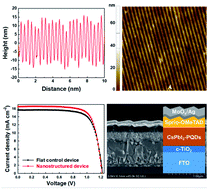A small-molecule-templated nanostructure back electrode for enhanced light absorption and photocurrent in perovskite quantum dot photovoltaics†
Abstract
Advances in the surface ligand exchange process of all-inorganic CsPbI3 perovskite colloidal quantum dots (PQDs) have enabled the fabrication of conductive PQD solids and their utilization as photovoltaic (PV) absorbers in next-generation solution-processed thin-film solar cells. However, PQD absorbers fabricated using the ligand exchange approach for application in high-efficiency PQD solar cells do not absorb, but transmit, a significant amount of the incident solar light. In addition, PQD absorbers are not suitable for fabricating thick films because of their short carrier diffusion length. Herein, we demonstrate that the introduction of nanophotonic structures in CsPbI3-PQD solar cells increases their light absorption via the light scattering effect, thereby improving their PV performance while maintaining the PQD absorber film thickness. We fabricate nanostructures on a spiro-OMeTAD hole-transport layer with sufficient film thickness and flexibility using nanoimprint lithography. We also find that a short spin-coating time is required to fabricate well-defined nanostructures on spiro-OMeTAD because of its high glass transition temperature. Thus, the nanostructured CsPbI3-PQD solar cells with a power conversion efficiency of up to 15.0% and a current density of 16.5 mA cm−2 show improved PV performance as compared to the flat control device with the same PQD absorber film thickness.



 Please wait while we load your content...
Please wait while we load your content...